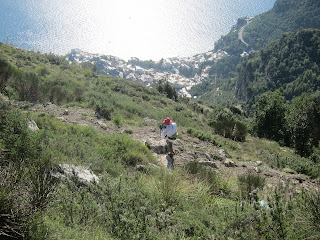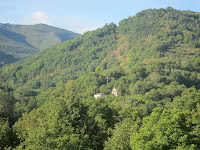 |
| Norman cathedral to schock and awe Trani |
-->
The Norsemen had been settled in Normandy
in the tenth century to stop them raiding and pillaging Paris. In the eleventh
century, poor leadership and political unrest enabled William the bastard to
win at Hastings in 1066 as every child knows. However, earlier in the century,
a number of Normans returning from pilgrimage to Jerusalem were hired as
mercenaries in southern Italy and made a name for themselves. Their success
attracted others and by 1040 they were winning battles in their own right.
Italy south of the Papal States had been governed by the Byzantines, mostly in
the east and in Sicily, with Lombard principalities in the west of the
mainland. Muslim raiders had captured Sicily and made life uncomfortable on the
western mainland. In this context, the Normans worked together (mostly) and by
1080 had effectively captured and ruled all of southern Italy and most of
Sicily.
 |
| Frederick II, chipped |
The leaders of this transformation were all
from the family of Hautevilles, many of them brothers. The star on the mainland
was Robert (the fox) Guiscard, who reliably defeated larger armies sent against
him by the (German) Holy Roman Emperor, the Pope and his various allies and the
Byzantines. In Sicily, most of the work was done by his younger brother, whose
son became Roger King of Sicily (which included the mainland) for the first
part of the twelfth century. Lack of good leadership in his sons led to enemies
looking to share in some of the wealth of the kingdom. His daughter Constance
was taken out of her convent to be married to Henry Vi of Germany and at the
age of 40 bore him a son, Frederick. Henry died and chaos reigned for a while
until Frederick claimed his patrimony. Through his parents, Frederick was able
to become both Holy Roman Emperor and King of Sicily, posing a serious threat
to the Pope.
 |
| Frederick's castle |
Frederick, known as “the wonder of the
world”, could speak seven languages, wrote a famous book on falconry from his
own reading and observations, established a centralized bureaucracy and a
university to provide it with bureaucrats and doctors. He has been credited
with creating the first modern state. While the government of the kingdom
passed first to the French and then to the Spanish and became progressively
impoverished, the outlines remained intact until the resorgimento in 1860.
We’ve been looking at the massive
Romanesque cathedrals built by the Normans to shock and awe their subjects and
opponents. Where the Greeks had small churches and managed by bureaucracy, the
Normans built fortress churches that soared into the sky with sheer walls and
ruled by fear until they constructed a bureaucracy much later. Their churches were built using modular techniques for
the basic components such as naves and columns and still make you gasp with their daring. A lot of columns and capitals from roman temples were recycled. Typically each church has a T-shaped floor plan with shallow apses, but
BIG and TALL with opportunities for theatre and relics.
 |
| Pantocrator 12th C |
Our
last two days were around Salerno, where Greco-Arabic medical
knowledge was first translated for the West in the 11thcentury. Those responsible were Alphanus of Salerno and Desiderius of Monte Cassino, together with Robert Guiscard. The political stability at Salerno in the preceding century had attracted wealthy merchants who could support learned doctors from Islam, Judaism, the Latin West and the Byzantine empire. The city became recognised for medical excellence to the extent that it's motto is still 'Civitas Hippocratico". They also built wonderful churches and used Byzantine artists and mosaicists
to challenge Constantinople for dazzling effects.
We start walking the Amalfi cliffs tomorrow.















































